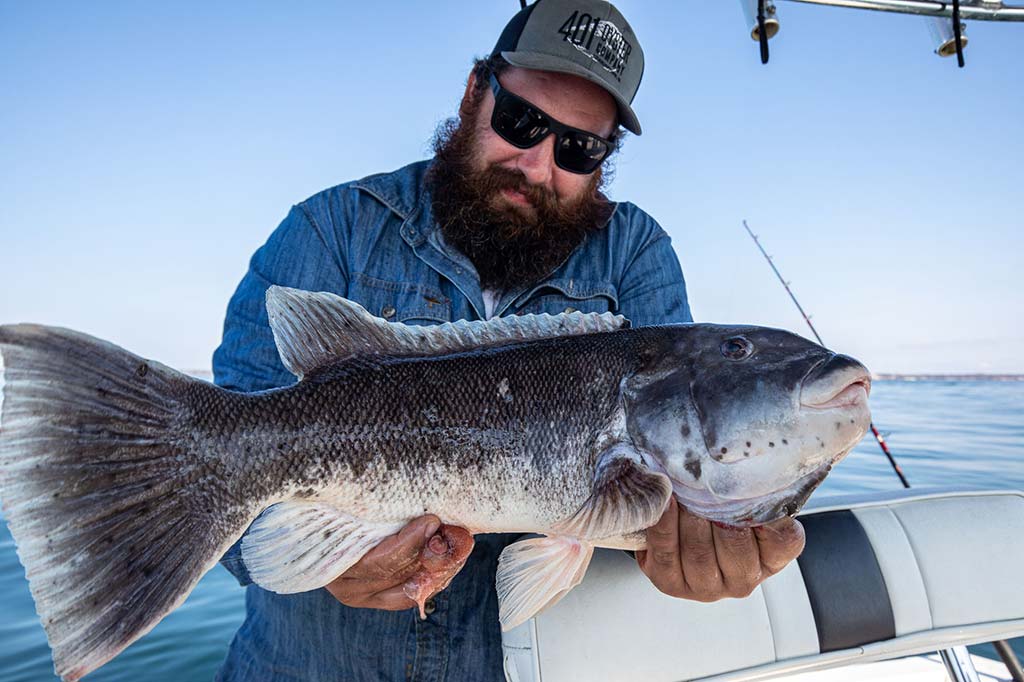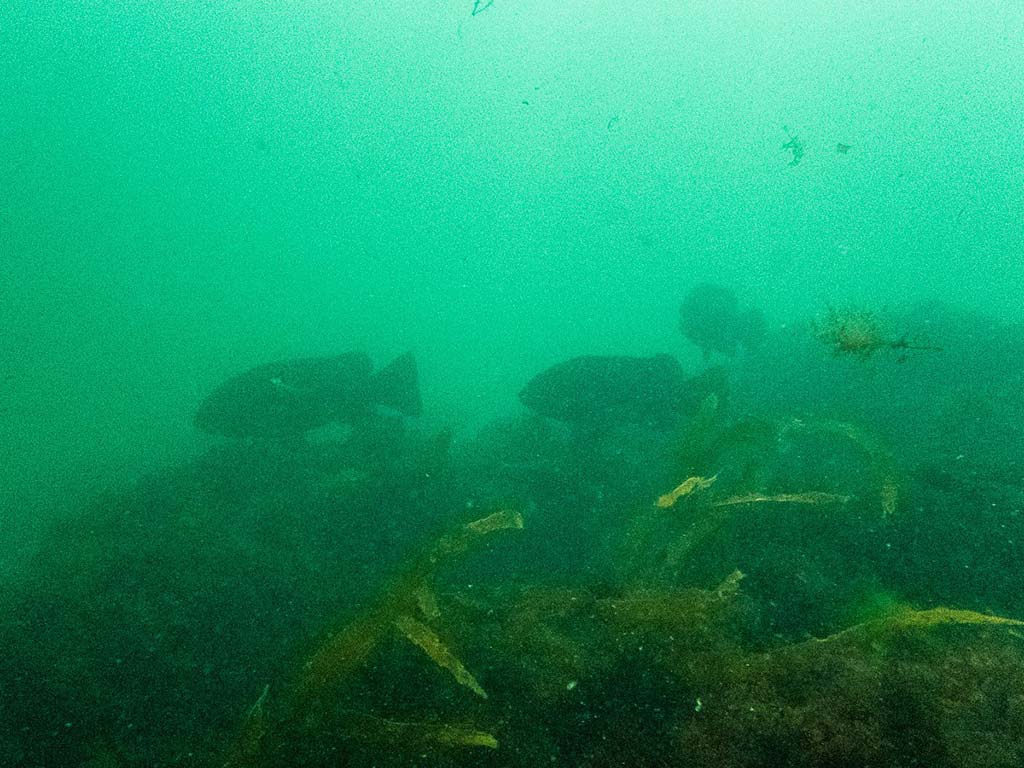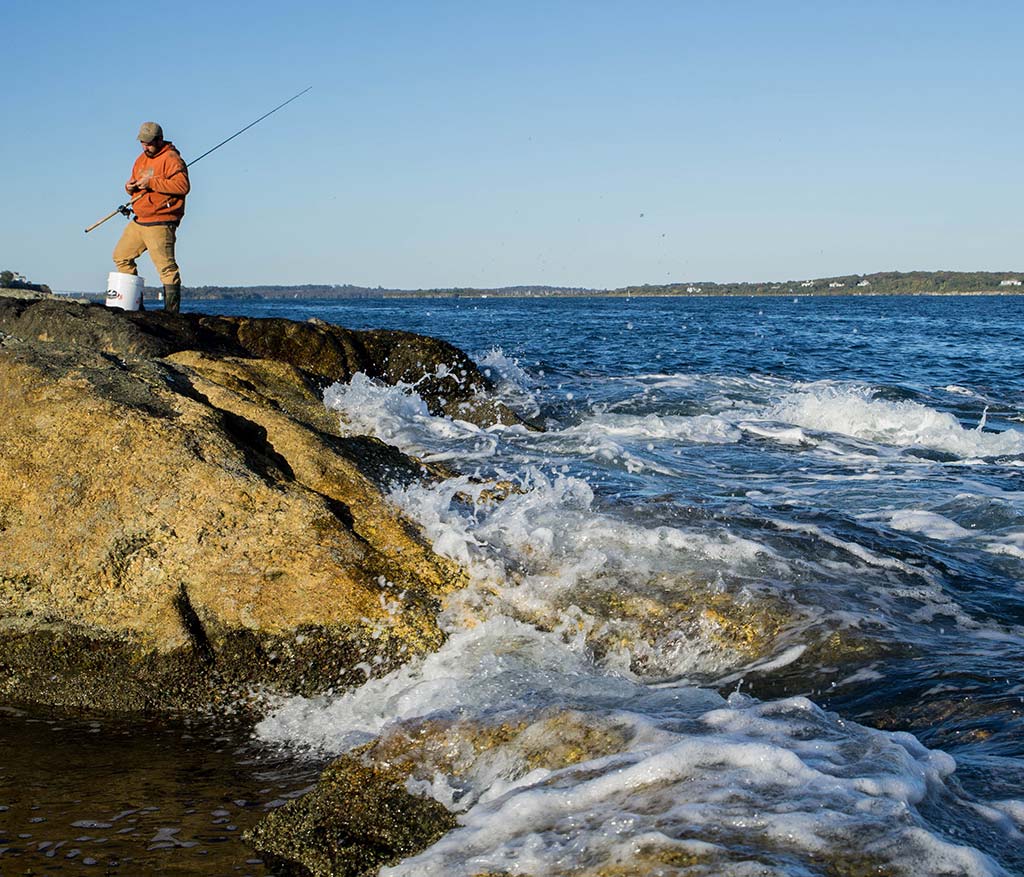
Early October offers your best shot at shallow water blackfish.
When early October comes, the clean air, the cool waters, I start thinking about blackfish. I don’t spend a whole lot of time thinking about rigs or jigs or rods or the latest trends. I like my blackfish simple and pure. One hook, one bank sinker, one crab. To me the fun of blackfishing is finding them, and a great time to find them is when the fish are running out from the shallows to the deep.
A good blackfish spot, once you have found one, done the work, gotten frustrated with hanging bottom, losing rigs, resetting the anchor, will give up fish season after season. Blackfish are loyal to the specific bottom that they hang on. The trick is finding that little piece of structure where the big fish gather. You might think that a long stretch of rocky coast should have blackfish all over it. It doesn’t.
Tight Quarters
In the early fall of this year I went for a shore dive with my son. Just a snorkel and a mask and wetsuit. There was a wreck we wanted to explore. In all the years that I’ve been swimming around with a mask on, I’ve never checked out this spot. We launched out and made the 100-yard swim. Soon, we could see the metal of the hull. Seeing a wreck underwater is always cool, mysterious, like you’re peering into the past. The front of the wreck was shallow, our bodies just barely floated over the top of it. As we swam down the hull we could see into it. Metal ribs, metal plating, sea weeds, bait, tons of small cunners and juvenile blackfish. Then as we started to move toward the stern the water grew deeper and the top of the wreck began to fade from sight. I kept diving down, 16 or so feet. Sea bass, a few small keeper blackfish, a sea robin. It was fishy but there wasn’t much size to the fish. We explored the sides of the hull, where the steel met sand. Again, fish, but nothing big.
Then at the end of the wreck, out in maybe 22 feet I dove down and hit sand. Behind me I could see the broken stern. In front of me I saw shapes, parts of the stern that lay just on the edge of my vision. I swam back to the surface, rested for a minute, swam out deeper, and dove down. When I hit bottom, I knew I was there. With blackfish, as a diver, you can sense it. I looked up. All around me, circling around this one piece of hull the size of a shopping cart were the adult blackfish that the previous 200 feet of wreck was devoid of. Yes, these blackfish, no question, were on this wreck, they just weren’t exactly where I thought they would be. This is typical blackfish behavior—the fish will be bunched up on a corner of a reef, and not uniformly spread out across it. This is what I have observed in the shallows.

Creature Comforts
What blackfish like – where they stage, and hang out – is impossible to say. But one thing is for certain: these fish have preferences. Places like Beavertail Point or the shorelines of Newport and Narragansett, at first glance, look like killer blackfish bottom, and it is, just not all of it. There are vast tracks of bottom that may have few adults on it. Blackfish are gregarious. They enjoy their own company.
Big blackfish love transitions; they love turbulence; they love mussel beds; they love bedrock on the edge of gravel. The transitions can be an edge of shallow ledge to depth, can be an edge of eel grass to boulders. They like the most prominent feature—the one big rock, the deepest drop. And they love motion. If you can find a deep drop with a lot of wave motion or current this is often close to where the aggregation of them will be.
Many of these features can be found right on the shore. You often don’t need to cast far. In fact, a cane pole would be a good method of capture. Pure and simple. Find a shelf on the shoreline. Find a ravine in the rock, a fissure. Blackfish love big cracks in the bedrock. The deeper the fissure the better. Jamestown and Newport are famous for this kind of thing. Drop the crab down to bottom and hang on.
Close To The Rocks
I know of many spots where the shore blackfishermen are casting over the fish. Some shorelines, Like Jamestown, where the drop off is more terraced, a long cast is often needed. But I would always recommend trying right at your feet to start. On many shore dives with my son we can swim to a known spot of mine and I tell him to dive down between the rocks and swim down the valley to the bottom. I tell him the blackfish will all be at the bottom of the valley, piled up down in there like a slumber party. Sure enough he’ll surface 30 seconds later and say: “Dad the fish are everywhere!” That’s a blackfish spot. And it will give up fish year after year.
Now not all is lost if you don’t know exactly where to cast. A run of rocky shoreline can all look the same, at least from our eyes. You stand there and try and narrow down your odds – shelves, white water, a place where a sandy cove meets rocky bottom. In these situations, use your best judgement on where to start and just start fishing. Try and make each cast in the same place. If a blackfish starts chewing on your crab let him. That sound of munching travels a long way underwater. I would even say, don’t set the hook on the first few chews. Let that fish demolish the crab. Cast another. Let it chew. When I’m diving and the fish are feeding on crabs or mussels you can hear that sound underwater. If I can hear it, they definitely can. The sound of a blackfish munching a hard-shell crab is the dinner bell for all the blackfish in that area. The fish will come.
When I am fishing for blackfish from shore I keep a short line. I go to spots where I don’t need to cast far at all. It’s more a lob. I use light sinkers. I like to fish in areas where fish are swimming through, migrating by. The peak time for this in Rhode Island is the first two weeks of October. Again, get the fish coming to you by baiting up with fresh crabs almost continuously. It should almost feel like work. Rarely are you just resting, hanging out, waiting for something to swim along and bite your crab.

Migrations
In New England we are lucky, we have many sounds and bays that have their own migrations of blackfish in the fall. The fish that move into Buzzards Bay, Narragansett Bay, Long Island Sound…they all have to move out in the fall. This is why places like Newport and Jamestown, Cuttyhunk and Westport, Fishers Island and Montauk are known for their blackfishing; migrations leaving the bays behind them must pass at their doorstep.
It really helps my confidence if I am fishing in a spot where I know a migration of blackfish could be running by my rod tip. Blackfish have a short migration – basically from fairly shallow water to somewhat deeper. I’m sure the blackfish that hang in 60 feet all summer hardly migrate at all. But when I’m fishing shallow, I want to get the best chance at a group of fish swimming by. If I don’t get a fish within 30 minutes or so I start thinking of a move. The move often isn’t much, a hundred yards or so. I try again. You want the current to be moving but you want the ocean to be calm. This is ideal. You also want the water to be fairly clean, not all stirred up from a big heave or blow.
One of my favorite boat spots for blackfish is in 16 feet of water. It’s on the outer edge of a reef that runs out from shore. The whole reef is submerged at mid-tide. This is one of those great in between spots – too tight for boats, too hard to access for shore casters. It would be the perfect kayak spot. The bottom here is very dark. The wave activity is intense. The big blackfish love it. I bring my kids here, sometime in early October. They can’t believe how shallow it is. And we bang the fish. We send the crabs down and get the fish coming. Few things make me happier than seeing one of my kids gripping a rod with all his life as a 9-pound blackfish in 12 feet of water tries to pull him over the rail. That’s bliss.


